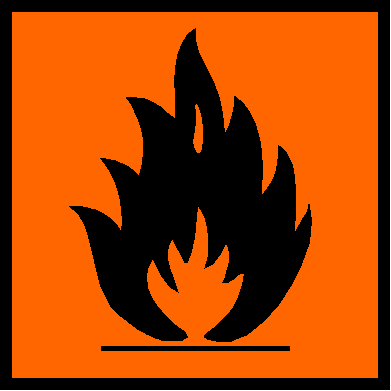| SECTION 1: Identification of the substance/mixture and of the company/undertaking |
| 1.2. Relevant identified uses of the substance or mixture and uses advised against |
| 1.3. Details of the supplier of the safety data sheet |
| CRC Industries UK Ltd. |
| Wylds Road |
| Castlefield Industrial Estate |
| TA6 4DD Bridgwater Somerset |
| United Kingdom |
| Tel.: +44 1278 727200 |
| Fax.: +44 1278 425644 |
| E-mail : hse.uk@crcind.com |
| Subsidiaries | | Tel | Fax |
| CRC Industries Deutschland GmbH | Südring 9, D-76473 Iffezheim | (07229) 303.0 | (07229)30 32 66 |
| 1.4. Emergency telephone number |
| (+44)(0)1278 72 7200
(office hours) |
| SECTION 2: Hazards identification |
| 2.1. Classification of the substance or mixture |
| Classification according to 67/548/EEC or 1999/45/EC: |
| Health: |
R36: Irritating to eyes. |
| | R67: Vapours may cause drowsiness and dizziness. |
| Physical: |
R12: Extremely flammable. |
| | EXTREMELY FLAMMABLE |
| Environment: |
Not classified |
| Warning symbol(s) : |
EXTREMELY FLAMMABLE |
| |  |
| | Xi : IRRITANT |
| |  |
| Risk-phrase(s) : |
R12: Extremely flammable. |
| | R36: Irritating to eyes. |
| | R67: Vapours may cause drowsiness and dizziness. |
| Safety-phrase(s) : |
S2: Keep out of the reach of children. |
| | S16: Keep away from sources of ignition - No smoking. |
| | S23: Do not breathe vapours/spray. |
| | S25: Avoid contact with eyes. |
| | S26: In case of contact with eyes, rinse immediately with plenty of water and seek medical advice. |
| | S51: Use only in well-ventilated areas. |
| Extra label elements according to Aerosol Dispenser Directive 75/324/EC: |
Pressurised container: protect from sunlight and do not expose to temperatures exceeding 50°C. Do not pierce or burn, even after use. Do not spray on a naked flame or any incandescent material. |
| SECTION 3: Composition/information on ingredients |
| Hazardous ingredient | CAS-nr. | EC-nr | w/w % | symbol | R-phrases* | Notes |
| propan-2-ol; isopropyl alcohol; isopropanol | 67-63-0 | 200-661-7 | 60-100 | F,Xi | 11-36-67 | B |
| carbon dioxide | 124-38-9 | 204-696-9 | 1-5 | - | - | A,G |
| Explanation notes |
A : substance with Community workplace exposure limit |
B : substance with national established workplace exposure limit |
G : exempted from the obligation to register in accordance with art.2(7)of REACH Regulation No 1907/2006 |
| Hazardous ingredient | Registration number | CAS-nr. | EC-nr | w/w % | Hazard Class and Category | Hazard statement | Notes |
| propan-2-ol; isopropyl alcohol; isopropanol | 01-2119457558-25 | 67-63-0 | 200-661-7 | 60-100 | Flam. Liq. 2, Eye Irrit. 2, STOT SE 3 | H225,H319,H336 | B |
| carbon dioxide | | 124-38-9 | 204-696-9 | 1-5 | Press. Gas | H280 | A,G |
| Explanation notes |
A : substance with Community workplace exposure limit |
B : substance with national established workplace exposure limit |
G : exempted from the obligation to register in accordance with art.2(7)of REACH Regulation No 1907/2006 |
| (* Explanation phrases : see chapter 16) |
| SECTION 4: First aid measures |
| 4.1. Description of first aid measures |
| Contact with eyes : |
If substance has got into eyes, immediately wash out with water for at least 15 minutes |
| | Seek medical advice |
| Contact with skin : |
Remove contaminated clothing immediately and drench affected skin with plenty of water. Then wash with soap and water |
| | Seek medical attention if irritation persists |
| Inhalation : |
Remove patient to fresh air |
| | Keep warm and at rest, in a half upright position. Loosen clothing |
| | Seek medical attention if ill effects occur |
| Ingestion : |
If swallowed accidentally, do not induce vomiting and seek medical advice. |
| 4.2. Most important symptoms and effects, both acute and delayed |
| Inhalation : |
Excessive inhalation of solvent vapours may give rise to nausea, headaches and dizziness |
| Ingestion : |
May cause gastrointestinal disturbances |
| | Symptoms : sore throat, abdominal pain, nausea, vomiting |
| Skin contact : |
May cause irritation. |
| | Symptoms : redness and pain |
| Eye contact : |
Irritating to eyes |
| | Symptoms : redness and pain |
| 4.3. Indication of any immediate medical attention and special treatment needed |
| General Advice : |
If you feel unwell, seek medical advice (show the label where possible |
| | If symptoms persist always call a doctor |
| SECTION 5: Firefighting measures |
| foam, carbon dioxide or dry agent |
| 5.2. Special hazards arising from the substance or mixture |
| Aerosols may explode if heated above 50°C |
| Forms hazardous decomposition products |
| CO,CO2 |
| 5.3. Advice for firefighters |
| Keep container(s) exposed to fire cool, by spraying with water |
| In case of fire, do not breathe fumes |
| SECTION 6: Accidental release measures |
| 6.1. Personal precautions, protective equipment and emergency procedures |
| Shut off all ignition sources |
| Ensure adequate ventilation |
| Wear suitable protective clothing and gloves. |
| 6.2. Environmental precautions |
| Do not allow to enter public sewers and watercourses |
| If polluted water reaches drainage systems or water courses, immediately inform appropriate authorities |
| 6.3. Methods and material for containment and cleaning up |
| Absorb spillage in suitable inert material |
| Place in appropriate container |
| 6.4. Reference to other sections |
| For further information see section 8 |
| SECTION 7: Handling and storage |
| 7.1. Precautions for safe handling |
| Keep away from heat and sources of ignition |
| Take precautionary measures against static discharges |
| Equipment should be earthed |
| Use explosion-proof electrical/ventilating/lighting/.../equipment. |
| Use only non-sparking tools. |
| Do not breathe aerosols or vapours. |
| Ensure adequate ventilation |
| Avoid contact with skin and eyes. |
| Wash thoroughly after use |
| Wear protective gloves/protective clothing/eye protection/face protection. |
| Eyewash bottles should be available |
| 7.2. Conditions for safe storage, including any incompatibilities |
| Pressurized container : protect from sunlight and do not expose to temperatures exceeding 50°C. |
| Keep out of reach of children. |
| SECTION 8: Exposure controls/personal protection |
| Hazardous ingredient | CAS-nr. | method | | |
| EU established exposure limits: |
| carbon dioxide | 124-38-9 | TWA | 5000 ppm |
| propan-2-ol; isopropyl alcohol; isopropanol | 67-63-0 | TWA | 400 ppm |
| | STEL | 500 ppm |
| National established exposure limits, United Kingdom |
| carbon dioxide | 124-38-9 | TWA | 5000 ppm |
| | STEL | 15000 ppm |
| Control procedures : |
Ensure adequate ventilation |
| | Keep away from heat and sources of ignition |
| | Take precautionary measures against static discharges |
| Personal protection : |
Take precautions to avoid contact with skin and eyes when handling the product. |
| | Ensure adequate ventilation |
| inhalation : |
In case of insufficient ventilation, wear suitable respiratory equipment. |
| hands and skin : |
Wear suitable protective gloves |
| eyes : |
Wear safety eyewear according to EN 166. |
| SECTION 9: Physical and chemical properties |
| 9.1. Information on basic physical and chemical properties |
| (for aerosols data for the product without propellant) |
| Appearance : physical state : |
Liquid under pressure. |
| Boiling point/range : |
82 °C |
| Flash point : |
12 °C (Open Cup) |
| Evaporation rate : |
Not available. |
| Explosion limits : upper limit : |
12 % |
| Vapour pressure : |
4.16 kPa (@ 20°C). |
| Relative density : |
0.785 g/cm3 (@ 20°C). |
| Solubility in water : |
Soluble in water |
| Viscosity : |
Not available. |
| SECTION 10: Stability and reactivity |
| No hazardous reactions known if used for its intended purpose |
| 10.3. Possibility of hazardous reactions |
| No hazardous reactions known if used for its intended purpose |
| 10.4. Conditions to avoid |
| 10.5. Incompatible materials |
| 10.6. Hazardous decomposition products |
| SECTION 11: Toxicological information |
| 11.1. Information on toxicological effects |
| Inhalation : |
Inhalation of solvent vapours may give rise to nausea, headaches and dizziness |
| Ingestion : |
May cause gastrointestinal disturbances |
| Skin contact : |
May cause irritation. |
| Eye contact : |
Irritating to eyes |
| Hazardous ingredient | CAS-nr. | method | | |
| propan-2-ol; isopropyl alcohol; isopropanol | 67-63-0 | LD50 oral rat | >2000 mg/kg |
| | LC50 inhal.rat | >20 mg/l |
| | LD50 derm.rabit | >2000 mg/kg |
| SECTION 12: Ecological information |
| Hazardous ingredient | CAS-nr. | method | | |
| propan-2-ol; isopropyl alcohol; isopropanol | 67-63-0 | IC50 algae | >100 mg/l |
| | LC50 fish | >100 mg/l |
| | EC50 daphnia | >100 mg/l |
| 12.2. Persistence and degradability |
| 12.3. Bioaccumulative potential |
| 12.5. Results of PBT and vPvB assessment |
| 12.6. Endocrine disrupting properties |
| SECTION 13: Disposal considerations |
| 13.1. Waste treatment methods |
| Product : |
This material and its container must be disposed of in a safe way. |
| | Do not discharge into drains or the environment, dispose to an authorised waste collection point. |
| Contaminated packaging : |
Disposal should be in accordance with local, state or national legislation |
| SECTION 14: Transport information |
| 14.2. UN proper shipping name |
| Proper shipping name: |
AEROSOLS |
| 14.3. Transport hazard class(es) |
| ADR/RID - Classification code: |
5F |
| Packing group: |
Not applicable. |
| 14.5. Environmental hazards |
| ADR/RID - Environmentally hazardous: |
No |
| IMDG - Marine pollutant: |
No |
| IATA/ICAO - Environmentally hazardous: |
No |
| 14.6. Special precautions for user |
| ADR/RID - Tunnelcode: |
(D) |
| 14.7. Maritime transport in bulk according to IMO instruments |
| SECTION 15: Regulatory information |
| 15.1. Safety, health and environmental regulations/legislation specific for the substance or mixture |
| The Safety Data Sheet is compiled according to the current European requirements. |
| Dir. 2013/10/EU, 2008/47/EC amendment of the aerosol dispenser directive 75/324/EEC. |
| EU-directive 99/45/EC
|
| Regulation (EC) No 1907/2006 (REACH)
|
| 15.2. Chemical safety assessment |
| SECTION 16: Other information |
| *Explanation hazard statements: |
H225 : Highly flammable liquid and vapour. |
| | H280 : Contains gas under pressure; may explode if heated. |
| | H319 : Causes serious eye irritation. |
| | H336 : May cause drowsiness or dizziness. |
This product should be stored, handled and used in accordance with good industrial hygiene practices and in conformity with any legal regulation.
The information contained herewith is based on the present state of our knowledge and is intended to describe our products from the point of view of safety requirements. It does not guarantee any specific properties.
Apart from any fair dealing for purposes of study, research and review of health, safety and environmental risks,no part of these documents may be reproduced by any process without written permission from CRC. |
|

